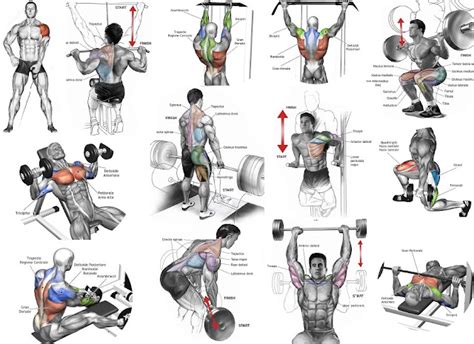Understanding Workout Splits for Muscle Growth
For men aiming to build significant muscle mass, selecting the right workout split is crucial. A well-designed split ensures that each muscle group receives adequate stimulation, recovery, and frequency to promote hypertrophy (muscle growth). While there’s no single ‘one-size-fits-all’ optimal split, certain approaches consistently outperform others when efficiency and science-backed principles are considered.
The primary goal is to provide sufficient training stimulus—volume, intensity, and frequency—without overtraining, allowing for consistent progressive overload. Let’s examine some popular splits and evaluate their effectiveness.

Popular Workout Splits and Their Efficacy
1. Full Body Split
- How it works: All major muscle groups are trained in each session, typically 3 times per week.
- Pros: High frequency for each muscle group (3x/week), excellent for beginners to learn movements and build foundational strength, good for recovery between sessions.
- Cons: Can be very long sessions as you advance, limited volume per muscle group per session.
- Optimal for: Beginners, individuals with limited training days, or those looking for general fitness. Less ideal for maximizing hypertrophy in advanced lifters.
2. Upper/Lower Split
- How it works: Divides workouts into upper body days and lower body days, usually trained 4 times per week (e.g., Upper, Lower, Rest, Upper, Lower, Rest, Rest).
- Pros: Allows for hitting each major muscle group twice a week (optimal frequency for hypertrophy), good balance of volume and recovery, suitable for intermediate lifters.
- Cons: Can lead to longer sessions on training days.
- Optimal for: Intermediate lifters seeking a balance of frequency and volume for muscle growth.

3. Push/Pull/Legs (PPL) Split
- How it works: Divides workouts into pushing movements (chest, shoulders, triceps), pulling movements (back, biceps), and leg movements. Typically done 6 days a week (Push, Pull, Legs, Push, Pull, Legs, Rest) or 3-4 days (PPL, Rest, PPL, Rest).
- Pros: Hits each muscle group twice a week when done 6 days, excellent for volume per muscle group, efficient grouping of synergist muscles, very popular and effective for hypertrophy.
- Cons: Requires high frequency (6 days/week) if opting for the double PPL, can be taxing on recovery if not managed properly.
- Optimal for: Intermediate to advanced lifters committed to frequent training and high volume.
4. Bro Split (Body Part Split)
- How it works: Each major muscle group is trained on a separate day (e.g., Chest Monday, Back Tuesday, Legs Wednesday, Shoulders Thursday, Arms Friday). Usually 5-6 days per week.
- Pros: Allows for very high volume on a single muscle group per session, popular in bodybuilding culture.
- Cons: Each muscle group is typically only trained once per week, which is sub-optimal for natural lifters aiming for maximum hypertrophy due to lower protein synthesis stimulation. Recovery for a particular muscle group can be too long between sessions.
- Optimal for: Advanced lifters with specific recovery abilities or those who prefer high single-session volume for specific muscle groups. Less efficient for most natural lifters.

The ‘Optimal’ Choice: Frequency and Progressive Overload
For most men aiming for efficient muscle gain, an optimal workout split will allow each major muscle group to be trained at least twice per week. This frequency is consistently shown in research to be superior for hypertrophy compared to once a week training.
Based on this principle, the Upper/Lower split and the Push/Pull/Legs (PPL) split (especially when executed twice a week) emerge as the strongest contenders for optimal muscle gain for intermediate and advanced natural lifters. They strike an excellent balance between training frequency, adequate volume, and sufficient recovery.

Beyond the Split: Maximizing Your Gains
While the split is important, it’s merely a framework. True muscle growth efficiency also hinges on several other critical factors:
- Progressive Overload: Consistently striving to lift more weight, perform more reps, or increase time under tension over time.
- Nutrition: Consuming a caloric surplus with adequate protein (around 1.6-2.2g per kg of body weight) to fuel muscle repair and growth.
- Recovery: Prioritizing 7-9 hours of quality sleep per night and managing stress.
- Consistency: Adhering to your chosen split and training regimen over the long term.
- Proper Form: Ensuring exercises are performed with correct technique to maximize muscle activation and minimize injury risk.

Conclusion
For men seeking to efficiently gain muscle mass, the optimal workout split will typically involve training each muscle group at least twice per week. This makes the Upper/Lower split and the Push/Pull/Legs (PPL) split outstanding choices for most individuals beyond the beginner stage. Experiment with these frameworks to find what best fits your schedule, recovery capacity, and preferences, always remembering that consistency, progressive overload, and solid nutrition are equally vital for success.




